
Friedensreich Hundertwasser (Friedensreich Hundertwasser, 1928-2000) is considered a revolutionary in the field of architecture, and the unique style he created is biomorphic and ecological. In the homeland of the famous and extraordinary Austrian artist and architect, a dozen and a half projects have been implemented, just a little less – in Germany, one project each – in the USA, Israel, Switzerland and New Zealand.
Smooth Line Mage
Friedensreich Hundertwasser in September 1985 at a press conference on the occasion of the completion of his project in Vienna – the Hundertwasser House (Hundertwasserhaus)
Hundertwasser was ahead of his time in many ways. Greening the roofs and balconies of their gray concrete box antipodes, he consistently returned the territory and space occupied by people to nature. Giving individuality to windows, he gave a person back the right of self-expression. In his work he continued to develop themes familiar and close to many of the works of Egon Schiele, Gustav Klimt and Antonio Gaudi.
“Green Citadel” Magdeburg
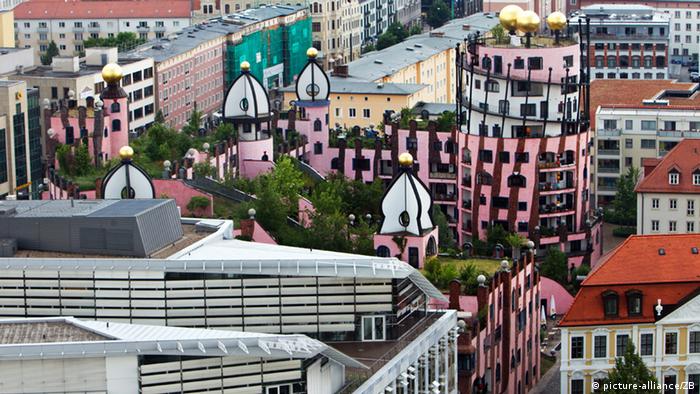
“Green Citadel” – Hundertwasser’s latest project
In Germany, thirteen projects were implemented, either fully developed by Hundertwasser or completed based on the author’s ideas and sketches after the architect’s death. Let’s start with the capital of Saxony-Anhalt – the city of Magdeburg, where in 2005 the construction of the “Green Citadel” (Grüne Zitadelle von Magdeburg) was completed.
The Green Citadel was Hundertwasser’s last project. Previously, a five-story panel building stood on this site, before it – the Church of St. Nicholas, which was badly damaged during the Second World War. In addition to apartments and shops, there is a kindergarten and a hotel. The roofs are covered in grass, and from no window you can’t see two windows in the same way.
snails and spirals

Friedensreich Hundertwasser’s painting “The Great Way” (“Der große Weg”, 1955) at an exhibition in Bremen
Hundertwasser’s favorite animals were snails with houses on their backs. Snail-like spirals became one of the signature elements of his work, as in this 1955 painting. Notable is the 1959 “Hundertwasser Performance”, during which Hundertwasser and his assistants spent two days and two nights painting in the living room. where his performance would later take place, a continuous line that started at the bottom of the wall.
“Forest Spiral” in Darmstadt
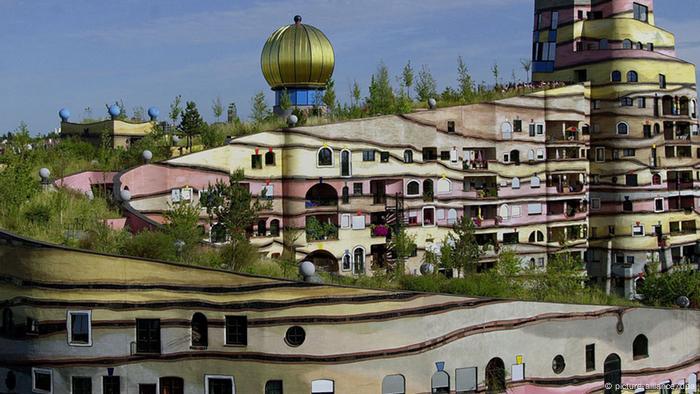
A thousand windows – none of them are the same
Hundertwasser continued this line in many of his subsequent works. In 2000, the residential complex “Forest Spiral” (Waldspirale) in the Hessian city of Darmstadt was completed. This 12-storey building has 105 apartments, an underground garage, bar, kiosk, children’s playground and lake in the courtyard.
Of the thousands of windows in Darmstadt’s “Forest Spiral”, none repeats the other, and they are located without a clear scheme and rigid symmetry. Some apartments are also decorated in the Hundertwasser style – with rounded corners, broken tile mosaics and other characteristic elements.
“Ecological house” in Hamm

“Glass Elephant” by Horst Relleke
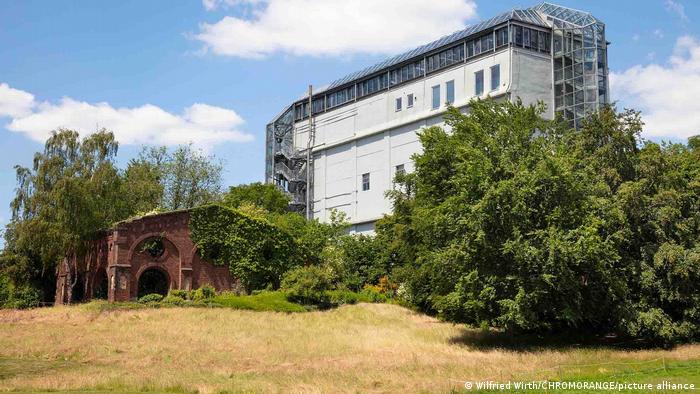
Former coal washing plant in Hamm, landscaped by Hundertwasser
Hundertwasser carried out one of his first projects in Germany in 1981-1982 in the town of Hamm in North Rhine-Westphalia. On the territory of the deactivated Zeche Maximilian mine, they decided to place a park and transform the old coal mine into an “Ecological House” (Öko-Haus). Hundertwasser has greened part of the roof here.
On the opposite side, visitors are greeted by the work of another architect – “Glass Elephant” Horst Rellecke (Horst Rellecke). This second half of Eco House highlights the contrast between the natural and the artificial. “Elephant” has become a symbol of the city. The “trunk” serves as a shaft for a panoramic elevator that leads to a viewpoint at a height of 35 meters.
“Nature Station” in Uelzen
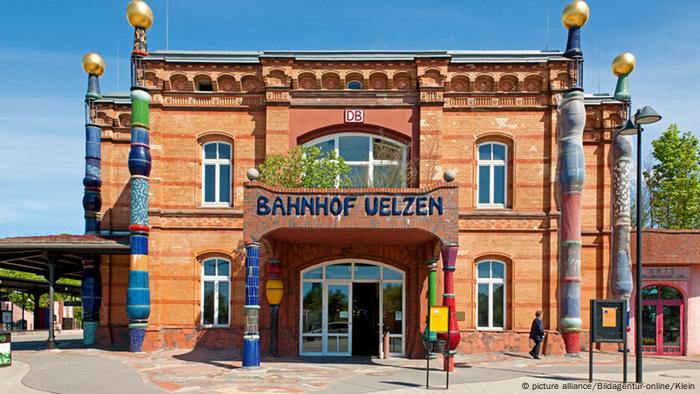
Train station 2009 in Germany
According to Hundertwasser’s designs in Germany, they not only built new buildings, but also gave old objects a new look. In preparation for the world exhibition EXPO 2000, held in the capital of Lower Saxony, Hannover, in one of the small towns of this land – Uelzen (Uelzen), the railway station was modernized, which has become a landmark of the entire region.
The project cost 10 million euros. The station turned out to be one of Hundertwasser’s last works. Every year it is visited by about 450 thousand people. In 2009 it was named “Season of the Year in Germany”. The prize is awarded by the public association Allianz pro Schiene in two categories: for railway stations in large and small towns.
Gym in Wittenberg
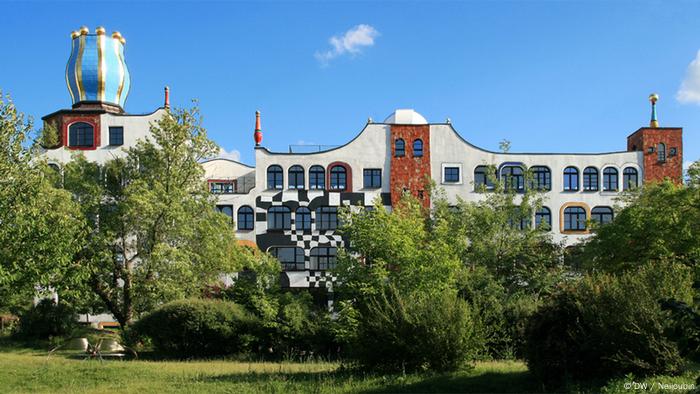
Martin Luther Gym in Wittenberg
Another hitherto indescribable building, transformed by Hundertwasser into an example of architectural nonconformity and ecologically correct construction, is located in Wittenberg, East Germany, birthplace of the Reformation and city of Martin Luther. This school was built from panel blocks according to a typical GDR design in 1975. In the mid-1990s, after German reunification, it needed repairs.
Thanks to a series of happy accidents, which we describe in detail in the photo essay “The Most Unusual School in Germany”, Hundertwasser was so excited by the idea that he was proposed to give this building a new look that he did the project for free. The renovation, which cost 9.5 million marks, was completed in 1999, a year before his death. The architect himself did not come to Wittenberg.
“House in the Meadows” in Bad Soden

Residential building in the Hessian resort of Bad Soden
The residential building in Bad Soden, built between 1990 and 1993, was designed based on a concept created by Hundertwasser for the development of a plot of land between two city parks. This resort, located in the Hessian region of Taunus, is known for its healing springs. As part of the Hundertwasser style project, the old 1772 kursaal and some houses were also rebuilt here.
“House in the Meadows” (“In den Wiesen”) is located in the territory with healing springs. In order not to interrupt the flow of groundwater, in Bad Soden they were forced to abandon the excavation of the foundation pit. The building was built on 250 piles driven into the ground at a depth of 15 meters. Some apartments are located on several levels. Each has a landscaped terrace or roof garden.
“Ronald McDonald’s House” in Essen
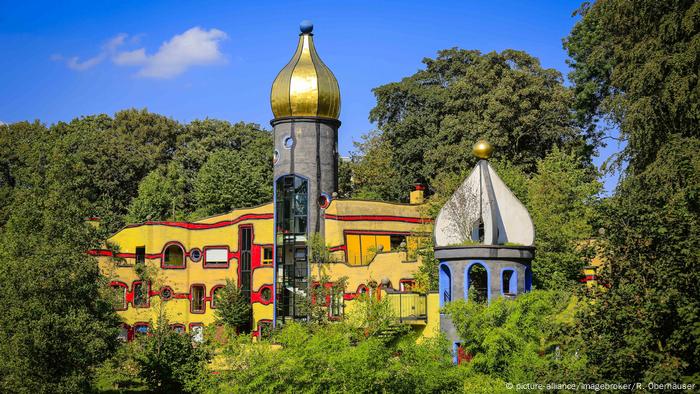
House with fabulous facades and bulbous towers in Essen
This building, designed by Hundertwasser, was built in Essen. This view opens from the pedestrian bridge between the Orangerie and the Botanical Gardens in the city’s Grugapark. Its construction was completed in 2005. The house belongs to the German branch of Ronald McDonald House Charity. This building houses families with seriously ill children during treatment at the University Hospital of Essen.
Dome at Wulfrath

Kindergarten and dome near Düsseldorf
In the style of Hundertwasser in Germany, this kindergarten “Düssel Gate” (Düsseler Tor) was built and a residential area in the city of Wülfrath, located about 30 kilometers from Düsseldorf. The artist and architect himself in 1999 created just a golden dome for him.
A street is named after the architect here: Friedensreich-Hundertwasser-Weg. But residents ran into a problem: the 29-letter, two-dash address doesn’t fit in the columns of forms when completing insurance, contracts, and so on, so they started using a shortened version: Hundertwasser-Weg.
Project in Plochingen
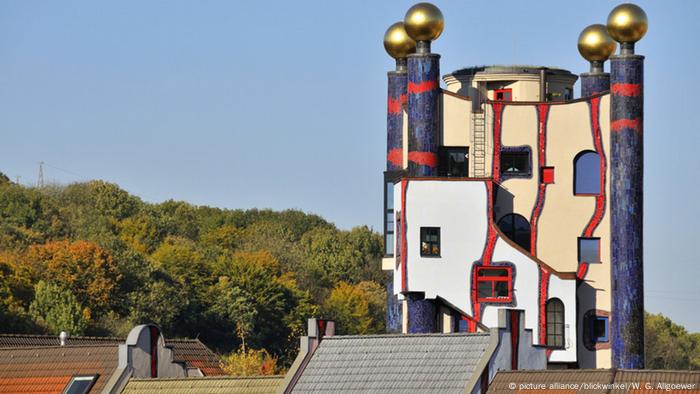
As part of the next project – “Live under the Rain Tower” (“Wohnen unterm Regenturm”), carried out in 1991-1994 in the city of Plochingen (Plochingen), near Stuttgart, the artist and architect managed to fully realize his ideas on philosophy of human habitation and its relationship with the environment.
Hundertwasser agreed to a proposal from Plochingen to decorate the courtyard of a new residential complex that was being designed in this city. At the same time, he himself expressed the desire to also deal with the facades facing the courtyard. He wanted the people in this courtyard to be completely surrounded by Hundertwasser’s world, become part of it and see only the sky above them.
Kuhlbauer brewery tower
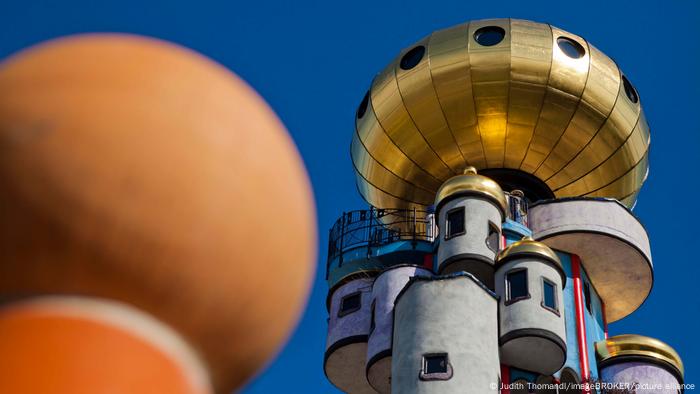
Tower of the Kuhlbauer brewery in the Bavarian town of Abensberg
This 34-meter tower was erected in the Bavarian town of Abensberg in 2007-2010 for the Kuchlbauer Brewery Museum. Hundertwasser died while it was being planned. Subsequently, the execution of the project with the participation of another architect was postponed due to a dispute. In the initial version of Hundertwasser, the height was supposed to reach 70 meters, but the authorities decided that this would detract from the historic appearance of the city.
With the exception of three projects, we know all of Hundertwasser’s work as an architect in Germany, where he also designed the facade and parking lot of the Rosenthal factory in Selb (1980-1982), a kindergarten in Frankfurt am Main (1988-1995) and a cafe in the Hamburg district of Ottensen (1998). Friedensreich Hundertwasser died on February 19, 2000 in New Zealand.
Source: DW
Lori Barajas is an accomplished journalist, known for her insightful and thought-provoking writing on economy. She currently works as a writer at 247 news reel. With a passion for understanding the economy, Lori’s writing delves deep into the financial issues that matter most, providing readers with a unique perspective on current events.